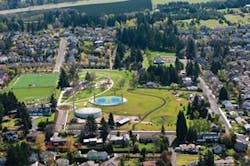Recreational Merit in the Midst of Expanding Capacity
In a family-oriented community in the Tualatin Valley, not far from Portland, Ore., the city of Sherwood is taking a proactive approach to meet the projected water supply needs for current and future development. Sherwood, one of the fastest growing cities in Oregon, has experienced phenomenal growth, nearly doubling its population since 1998, and has surpassed its current water supply. As a first step in a key project to connect Sherwood water lines to the Wilsonville water treatment plant, the city has completed a new 4-million-gal water storage tank, located in one of the most popular parks in the city, Snyder Park. This new storage tank supplements existing storage in a 58-year-old reservoir and will accommodate residential, commercial and light industry expansion and its demand for additional water storage capacity.
The city of Sherwood investigated several options to increase water storage capacity as well as improve water pressure and reliability, all while meeting current seismic and building code requirements. The city hired a design team consisting of Murray, Smith & Associates Inc., Portland, engineer; and Peterson Structural Engineers Inc., Portland, structural engineer. Construction was completed by Emery and Sons Inc., Salem, Ore., general contractor; Marion Construction Co. Inc., Salem, tank contractor; and DYK Inc. , El Cajon, Calif., tank prestressor.
Picking a Winner
After careful consideration of the environmental impacts and long-term benefits of the different options, the city determined that prestressed concrete would offer the highest-quality, longest-lasting and lowest-maintenance water storage structure for this project. The tank has an inside diameter of 155 ft, a wall height of 31 ft and a surface water depth of 30 ft.
All construction joints incorporate PVC water stops to ensure a watertight structure. A 10-in.-thick, cast-in-place, flat concrete roof is supported by 52 concrete columns, each 24 in. in diameter. The 10-in.-thick poured-in-place walls of the tank were both circumferentially and vertically prestressed by DYK Inc. Vertical post-tensioning was achieved with 120 1.25-in.-diameter vertical tendons. Circumferential prestressing was completed with 3/8-in.-diameter seven-wire galvanized strand and protected with several coats of automatically applied shotcrete.
The entire prestressing and shotcreting operation was completed using one of the world’s most technologically advanced, fully automated machines to ensure that the specified quality control was consistently maintained. DYK’s prestressing machine continuously and electronically monitored an applied stressing force of 14,950 lb on the strand as it was applied. The project was made more economical by the use of a prestressed concrete tank to accomplish both structural and environmental design needs achieving a high-strength, low-maintenance, watertight structure.
The project posed challenges for the management team, given the tank's location in a popular recreational park and the close proximity to residential housing. The selection of a prestressed concrete tank gave the city the ability to partially bury it, thereby reducing the aesthetic impact to the surrounding neighborhoods and maximizing the open spaces for recreation in the park. Upon completion, two lighted, fenced tennis courts were installed on the exposed roof of the tank, making it an excellent dual use of land for the city.
Becoming a Winner
Completion of the 4-million-gal "Sunset #2" Tank and Pump Station Project reflects a vital contribution to the Sherwood community by providing important and reliable source of water to accommodate recent and future growth with the additional benefits of long service life and minimal maintenance requirements.
The project won several awards, including the Pacific Northwest Section of the American Water Works Assn.'s 2010 Excellence in Engineering award for best large project greater than $8 million, Oregon Section of American Public Works Assn. Project of the Year Award, 2010 Design Award of Oregon Recreation and Parks Assn., 2010 Excellence in Concrete Award of Oregon Concrete & Aggregate Producers Assn. and the Oregon Chapter of the American Concrete Institute. The project was also selected as one of the Best of 2010 by Northwest Construction magazine.
